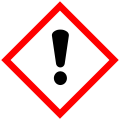

In the process industry, chemical industry, manufacturing industry, and other commercial and industrial contexts, pipe marking is used to identify the contents, properties and flow direction of fluids in piping. It is typically carried out by marking piping through labels and color codes. Pipe marking helps personnel and fire response teams identify the correct pipes for operational, maintenance or emergency response purposes.
Contents
- Background
- National standards: United States
- ANSI/ASME Standards
- 2015 revisions
- IIAR Bulletin #114
- NFPA 99C 2002
- National standards: United Kingdom
- BS 1710 Safety colours and signs
- National standards: India
- IS 2379 Pipelines Identification Colour Code
- National standards: Australia
- International standards
- ISO 14726 Ships and marine facilities
- ISO 20560-1 & -2 Safety information for piping systems
- European standards: RAL Colours
- See also
- Notes
- References








